Development of A Spatiotemporal Database for Evolution Analysis of the Moscow Backbone Power Grid
Abstract
:1. Introduction
2. Materials and Methods
2.1. Data Collecting
2.2. Data Structure
3. Results
3.1. Morphology Evolution Analysis
3.2. Web Service Development
4. Conclusions
Supplementary Materials
Author Contributions
Funding
Institutional Review Board Statement
Informed Consent Statement
Data Availability Statement
Conflicts of Interest
References
- Xie, F.; Levinson, D. Topological Evolution of Surface Transportation Networks. Comput. Environ. Urban Syst. 2009, 33, 211–223. [Google Scholar] [CrossRef] [Green Version]
- Strano, E.; Nicosia, V.; Latora, V.; Porta, S.; Barthélemy, M. Elementary Processes Governing the Evolution of Road Networks. Sci. Rep. 2012, 2, 296. [Google Scholar] [CrossRef] [PubMed] [Green Version]
- Pablo-Martí, F.; Alañón-Pardo, Á.; Sánchez, A. Complex Networks to Understand the Past: The Case of Roads in Bourbon Spain. Cliometrica 2021, 15, 477–534. [Google Scholar] [CrossRef] [PubMed]
- Tero, A.; Takagi, S.; Saigusa, T.; Ito, K.; Bebber, D.P.; Fricker, M.D.; Yumiki, K.; Kobayashi, R.; Nakagaki, T. Rules for Biologically Inspired Adaptive Network Design. Science 2010, 327, 439–442. [Google Scholar] [CrossRef] [Green Version]
- Roth, C.; Kang, S.M.; Batty, M.; Barthelemy, M. A Long-Time Limit for World Subway Networks. J. R. Soc. Interface 2012, 9, 2540–2550. [Google Scholar] [CrossRef]
- Santos, A.D.F.; Valério, D.; Tenreiro Machado, J.A.; Lopes, A.M. A Fractional Perspective to the Modelling of Lisbon’s Public Transportation Network. Transportation 2019, 46, 1893–1913. [Google Scholar] [CrossRef]
- Chen, Y.; Jin, F.; Lu, Y.; Chen, Z.; Yang, Y. Development History and Accessibility Evolution of Land Transportation Network in Beijing-Tianjin-Hebei Region over the Past Century. J. Geogr. Sci. 2018, 28, 1500–1518. [Google Scholar] [CrossRef] [Green Version]
- Yang, D.; Wang, K.Y.; Xu, H.; Zhang, Z. Path to a Multilayered Transshipment Port System: How the Yangtze River Bulk Port System Has Evolved. J. Transp. Geogr. 2017, 64, 54–64. [Google Scholar] [CrossRef]
- Rodrigue, J.-P.; Comtois, C.; Slack, B. The Geography of Transport Systems, 4th ed.; Routledge: London, UK, 2016. [Google Scholar] [CrossRef]
- Tarhov, S.A. Evolutionary Morphology of Transport Networks; Universum: Smolensk, Russia, 2005. [Google Scholar]
- Miller, H.J.; Goodchild, M.F. Data-driven geography. GeoJournal 2015, 80, 449–461. [Google Scholar] [CrossRef]
- Newman, M.E.J. Networks, 2nd ed.; Oxford University Press: Oxford, UK; New York, NY, USA, 2018; ISBN 978-0-19-880509-0. [Google Scholar]
- Barthelemy, M. Betweenness Centrality. In Morphogenesis of Spatial Networks; Lecture Notes in Morphogenesis; Springer International Publishing: Cham, Switzerland, 2018; pp. 51–73. ISBN 978-3-319-20564-9. [Google Scholar]
- Boccaletti, S.; Latora, V.; Moreno, Y.; Chavez, M.; Hwang, D. Complex Networks: Structure and Dynamics. Phys. Rep. 2006, 424, 175–308. [Google Scholar] [CrossRef]
- Pagani, G.A.; Aiello, M. The Power Grid as a Complex Network: A Survey. Phys. A Stat. Mech. Appl. 2013, 392, 2688–2700. [Google Scholar] [CrossRef] [Green Version]
- Rosas-Casals, M. Power Grids as Complex Networks: Topology and Fragility. In Proceedings of the 2010 Complexity in Engineering, Roma, Italy, 22–24 February 2010; pp. 21–26. [Google Scholar]
- Chaitanya, V.V.R.V.; Mohanta, D.K.; Reddy, M.J.B. Topological Analysis of Eastern Region of Indian Power Grid. In Proceedings of the 2011 10th International Conference on Environment and Electrical Engineering, Rome, Italy, 8–11 May 2011; pp. 1–4. [Google Scholar]
- Faddeev, A. Assessment of Vulnerability of Power Systems of Russia, CIS Countries and Europe to Cascade Accidents. Bull. Mosc. Univ. Ser. 5 Geogr. 2016, 1, 46–53. [Google Scholar]
- Arianos, S.; Bompard, E.; Carbone, A.; Xue, F. Power Grid Vulnerability: A Complex Network Approach. Chaos 2009, 19, 013119. [Google Scholar] [CrossRef] [PubMed]
- Rosato, V.; Bologna, S.; Tiriticco, F. Topological Properties of High-Voltage Electrical Transmission Networks. Electr. Power Syst. Res. 2007, 77, 99–105. [Google Scholar] [CrossRef]
- Bompard, E.; Pons, E.; Wu, D. Analysis of the structural vulnerability of the interconnected power grid of continental Europe with the Integrated Power System and Unified Power System based on extended topological approach. Int. Trans. Electr. Energy Syst. 2013, 23, 620–637. [Google Scholar] [CrossRef] [Green Version]
- Makrushin, S. Analysis of Russian Power Transmission Grid Structure: Small World Phenomena Detection. In Proceedings of the NET 2016: Models, Algorithms, and Technologies for Network Analysis, Nizhny Novgorod, Russia, 26–28 May 2016; Kalyagin, V., Nikolaev, A., Pardalos, P., Prokopyev, O., Eds.; Springer: Cham, Switzerland, 2017; Volume 197. [Google Scholar] [CrossRef]
- Buzna, L.; Issacharoff, L.; Helbing, D. The Evolution of the Topology of High-Voltage Electricity Networks. IJCIS 2009, 5, 72. [Google Scholar] [CrossRef]
- Liu, X.; Liu, T.; Li, X. A Novel Evolving Model for Power Grids. Sci. China Technol. Sci. 2010, 53, 2862–2866. [Google Scholar] [CrossRef]
- Deka, D.; Vishwanath, S. Generative Growth Model for Power Grids. In Proceedings of the 2013 International Conference on Signal-Image Technology & Internet-Based Systems, Kyoto, Japan, 2–5 December 2013; pp. 591–598. [Google Scholar]
- Luo, L.; Han, B.; Rosas-Casals, M. Network Hierarchy Evolution and System Vulnerability in Power Grids. IEEE Syst. J. 2018, 12, 2721–2728. [Google Scholar] [CrossRef] [Green Version]
- Rosas-Casals, M.; Valverde, S.; Sole, R. A Simple Spatiotemporal Evolution Model of a Transmission Power Grid. IEEE Syst. J. 2018, 12, 3747–3754. [Google Scholar] [CrossRef]
- Кoпенкина, Л.В. Первая Электрoстанция На Тoрфе (к 100-Летию Сoздания). Труды Инстoрфа 2012, 59, 46–51. [Google Scholar]
- Белoсельский, Б.С. Знаменательные Даты в Истoрии Энергетики Мoсквы и Мoскoвскoгo Региoна. Теплoэнергетика 1997, 10, 77–78. [Google Scholar]
- Zhang, X.; Yuan, X.; Yuan, Y. New Method for Designing the Spatial Database of Power Network. Electr. Power 2007, 40, 75–79. [Google Scholar]
- Lin, F.; Lin, Y.; Zhang, H.; Huang, D. Power quality monitoring and its visualization application based on graph database. In Proceedings of the 2021 6th Asia Conference on Power and Electrical Engineering, ACPEE, Chongqing, China, 8–11 April 2021; pp. 1160–1167. [Google Scholar] [CrossRef]
- Vassilakopoulos, M. Spatial Network Databases. In Handbook of Research on Innovations in Database Technologies and Applications; Ferraggine, V.E., Doorn, J.H., Rivero, L.C., Eds.; IGI Global: Hershey, PA, USA, 2009; pp. 307–315. ISBN 978-1-60566-242-8. [Google Scholar]
- Kanjilal, V.; Schneider, M. Modeling and Querying Spatial Networks in Databases. J. Multimed. Process. Technol. 2010, 1, 142–159. [Google Scholar]
- Tongyu, X.; Yuncheng, Z.; Yingli, C. Topology Analysis and Design of Power Distribution Network Spatial Database Based on GUID Code. In Advanced Technology in Teaching, Proceedings of the 2009 3rd International Conference on Teaching and Computational Science (WTCS 2009), Shenzen, China, 19–20 December 2009; Wu, Y., Ed.; Advances in Intelligent and Soft Computing; Springer: Berlin/Heidelberg, Germany, 2012; Volume 117, pp. 97–104. ISBN 978-3-642-25436-9. [Google Scholar]
- Rahman, M.A.; Abdul Maulud, K.N.; Saiful Bahri, M.A.; Hussain, M.S.; Ridzuan Oon, A.O.; Suhatdi, S.; Che Hashim, C.H.; Mohd, F.A. Development of GIS Database for Infrastructure Management: Power Distribution Network System. IOP Conf. Ser. Earth Environ. Sci. 2020, 540, 012067. [Google Scholar] [CrossRef]
- Zhu, J.; Zhuang, E.; Ivanov, C.; Yao, Z. A Data-Driven Approach to Interactive Visualization of Power Systems. IEEE Trans. Power Syst. 2011, 26, 2539–2546. [Google Scholar] [CrossRef]
- Mota, A.A.; Mota, L.T.M.; Morelato, A. Visualization of Power System Restoration Plans Using CPM/PERT Graphs. IEEE Trans. Power Syst. 2007, 22, 1322–1329. [Google Scholar] [CrossRef]
- Fischer, M.T. Towards a Survey of Visualization Methods for Power Grids. arXiv 2021, arXiv:2106.04661. Available online: http://arxiv.org/abs/2106.04661 (accessed on 25 November 2021).
- Dong, X.; Shinozuka, M. Performance analysis and visualization of electric power systems. In Proceedings of the Smart Structures and Materials 2003: Smart Systems and Nondestructive Evaluation for Civil Infrastructures, San Diego, CA, USA, 3–6 March 2003. [Google Scholar] [CrossRef]
- Hock, K.P.; McGuiness, D. Future State Visualization in Power Grid. In Proceedings of the 2018 IEEE International Conference on Environment and Electrical Engineering and 2018 IEEE Industrial and Commercial Power Systems Europe (EEEIC/I&CPS Europe), Palermo, Italy, 12–15 June 2018; pp. 1–6. [Google Scholar] [CrossRef]
- Ma, G.; Pang, N.; Hu, B.; Zhang, Z. Analysis and Research on Visualization Display Model of Power Network Planning Based on Big Data Analysis. IOP Conf. Ser. Mater. Sci. Eng. 2020, 782, 032010. [Google Scholar] [CrossRef]
- Milano, F. Three-Dimensional Visualization and Animation for Power Systems Analysis. Electr. Power Syst. Res. 2009, 79, 1638–1647. [Google Scholar] [CrossRef]
- Gegner, K.M.; Overbye, T.J.; Shetye, K.S.; Weber, J.D. Visualization of Power System Wide-Area, Time Varying Information. In Proceedings of the 2016 IEEE Power Energy Conference at Illinois (PECI), Urbana, IL, USA, 19–20 February 2016; pp. 1–4. [Google Scholar] [CrossRef]
- Overbye, T.J.; Weber, J.D. Visualization of Power System Data. In Proceedings of the 33rd Annual Hawaii International Conference on System Sciences, Maui, HI, USA, 7 January 2000. [Google Scholar] [CrossRef] [Green Version]
- Kargashin, P.E.; Novakovskiy, B.A.; Prasolova, A.I.; Karpachevskiy, A.M. Study of the Electrical Grid Spatial Configuration with Satellite Images. Geodesy Cartogr. 2016, 909, 50–55. [Google Scholar] [CrossRef]
- Google Earth Pro. Available online: https://www.google.ru/intl/ru/earth/versions/#earth-pro (accessed on 23 November 2021).
- Нoвакoвский, Б.А.; Карпачевский, А.М. Электрические Сети: Картoграфирoвание и Геoграфический Анализ; Издательствo МИИГАиК: Мoсква, Russia, 2020; ISBN 978-5-91188-078-1. [Google Scholar]
- Earth Explorer. Available online: https://earthexplorer.usgs.gov/ (accessed on 23 November 2021).
- QGIS. Available online: https://www.qgis.org/ru/site/ (accessed on 23 November 2021).
- KML Documentation. Available online: https://developers.google.com/kml/documentation/kml_tut (accessed on 23 November 2021).
- ArcGIS Desktop. Available online: https://www.esri.com/en-us/arcgis/products/arcgis-desktop/overview (accessed on 23 November 2021).
- Mosenergo Museum. Available online: https://museum.rossetimr.ru/detail.php?ELEMENT_ID=995 (accessed on 23 November 2021).
- Mosenergo Museum. Available online: https://minenergo.mosreg.ru/dokumenty/napravleniya-deyatelnosti/elektroenergetika/24-05-2021-09-34-28-proekt-skhemy-i-programmy-perspektivnogo-razvitiya (accessed on 23 November 2021).
- Wickham, H. Tidy Data. J. Stat. Soft. 2014, 59, 1–23. [Google Scholar] [CrossRef] [Green Version]
- Open Geospatial. Available online: https://docs.opengeospatial.org/is/18-000/18-000.html (accessed on 23 November 2021).
- Mariotto, F.P.; Antoniou, V.; Drymoni, K.; Bonali, F.L.; Nomikou, P.; Fallati, L.; Karatzaferis, O.; Vlasopoulos, O. Virtual Geosite Communication through a WebGIS Platform: A Case Study from Santorini Island (Greece). Appl. Sci. 2021, 11, 5466. [Google Scholar]
- Balla, D.; Zichar, M.; Tóth, R.; Kiss, E.; Karancsi, G.; Mester, T. Geovisualization Techniques of Spatial Environmental Data Using Different Visualization Tools. Appl. Sci. 2020, 10, 6701. [Google Scholar] [CrossRef]
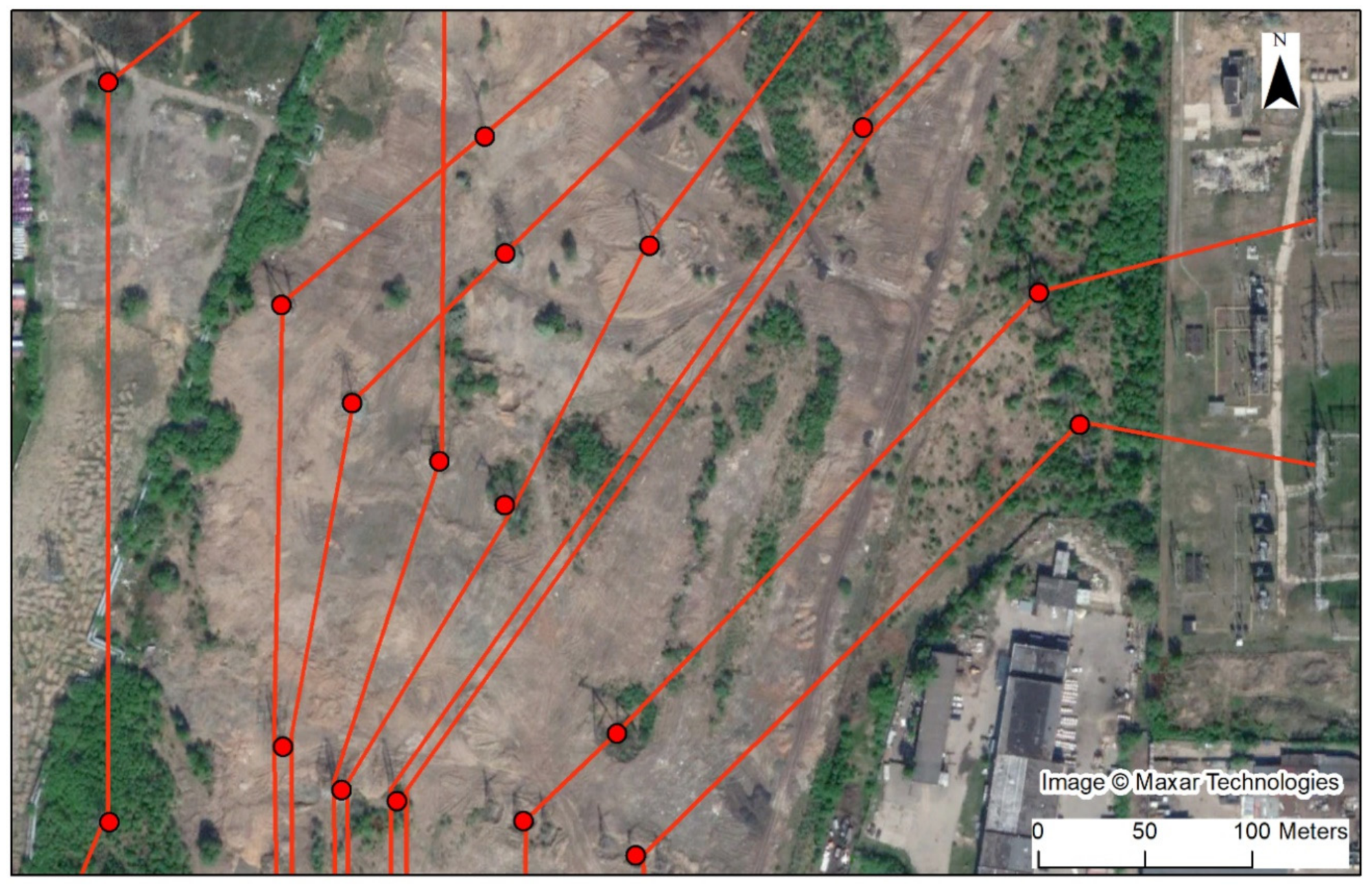
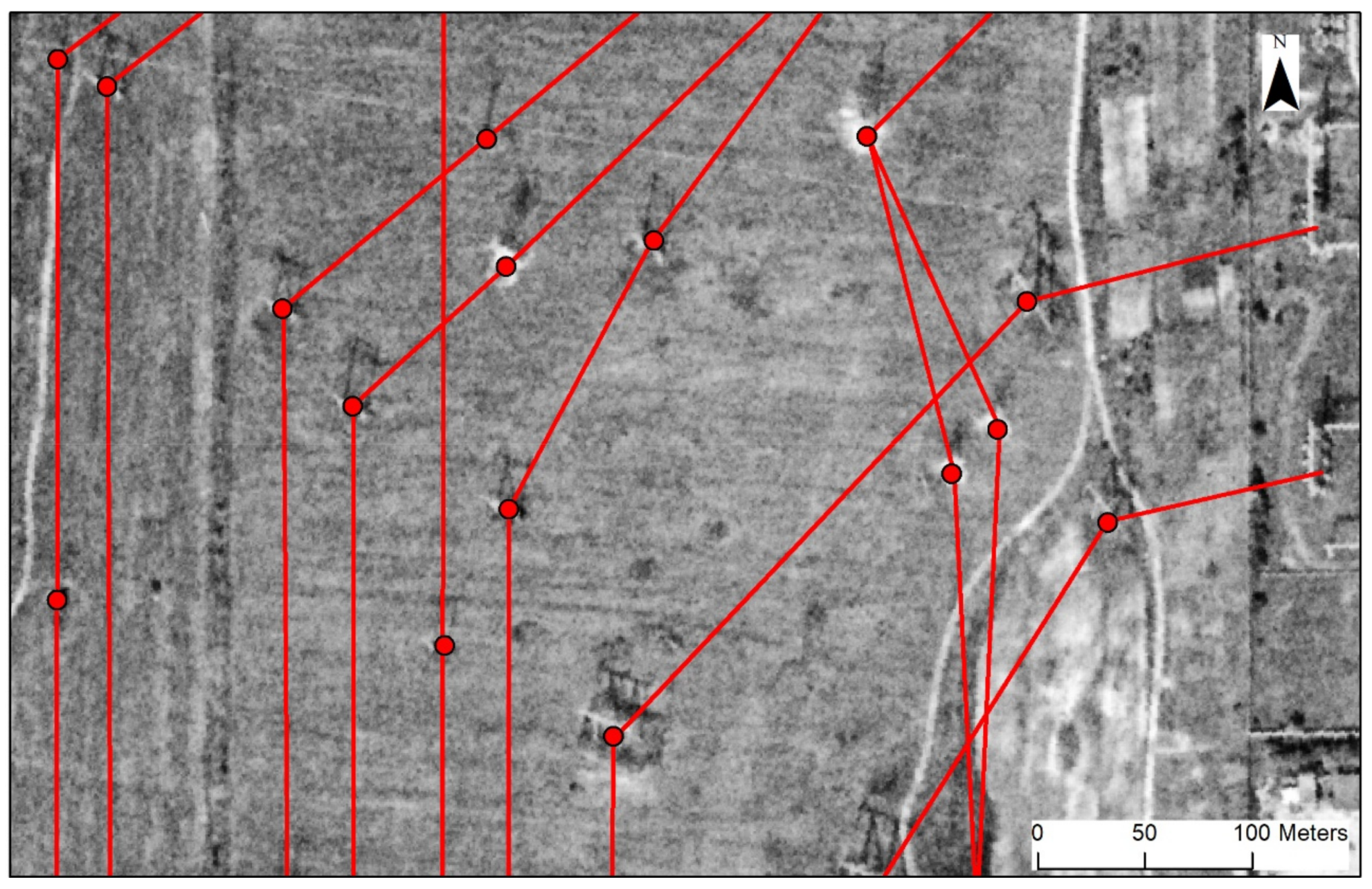
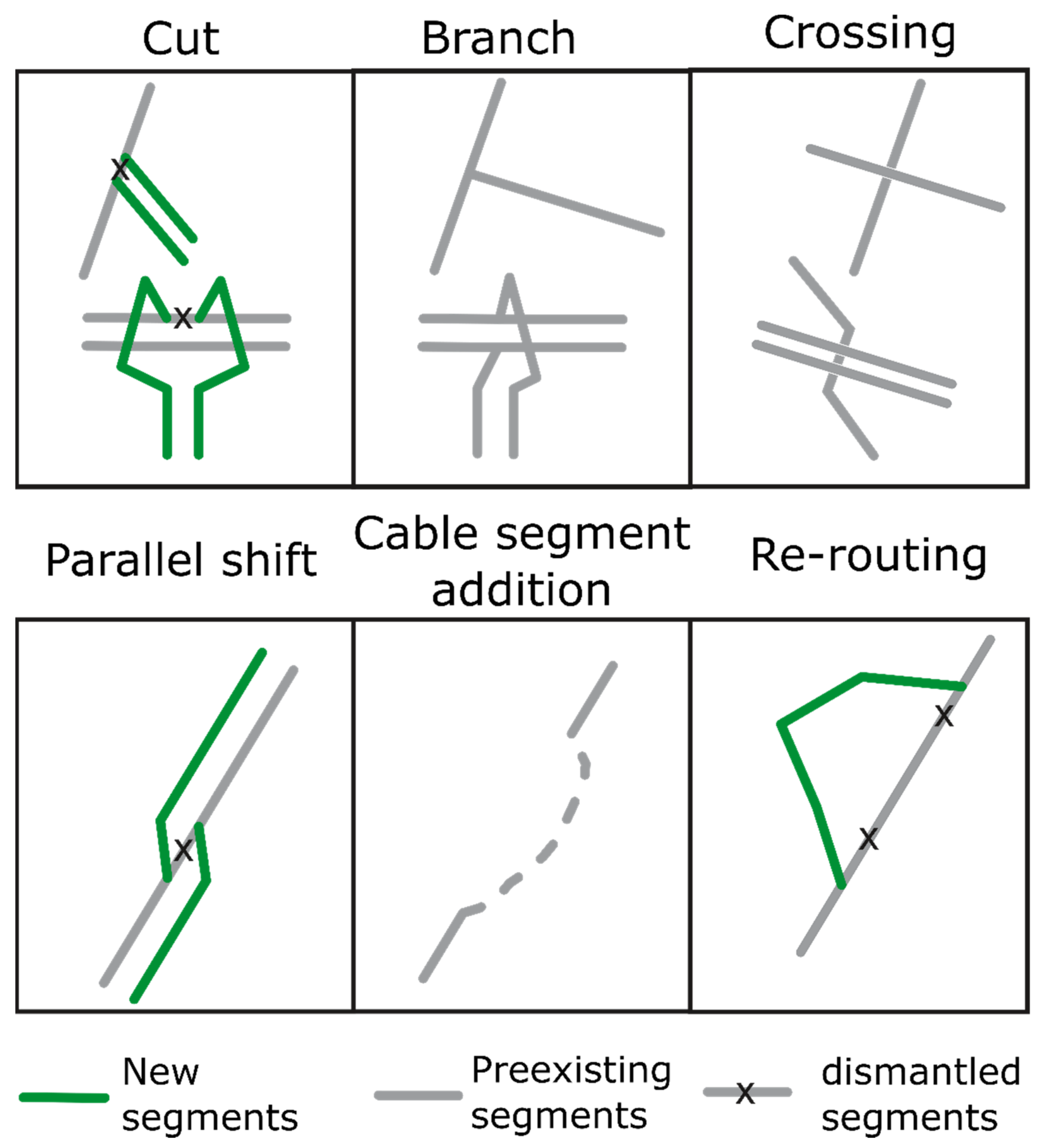
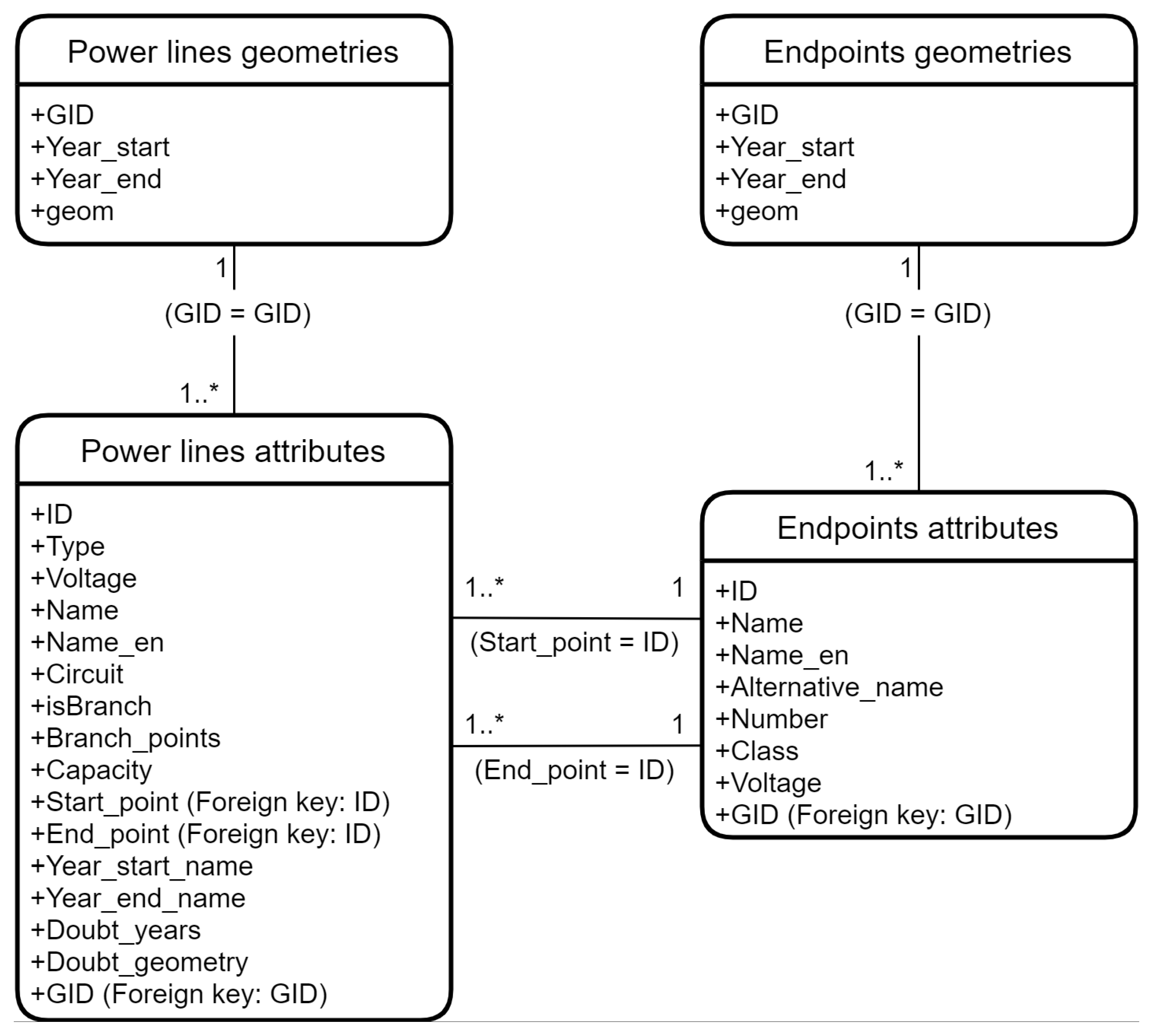
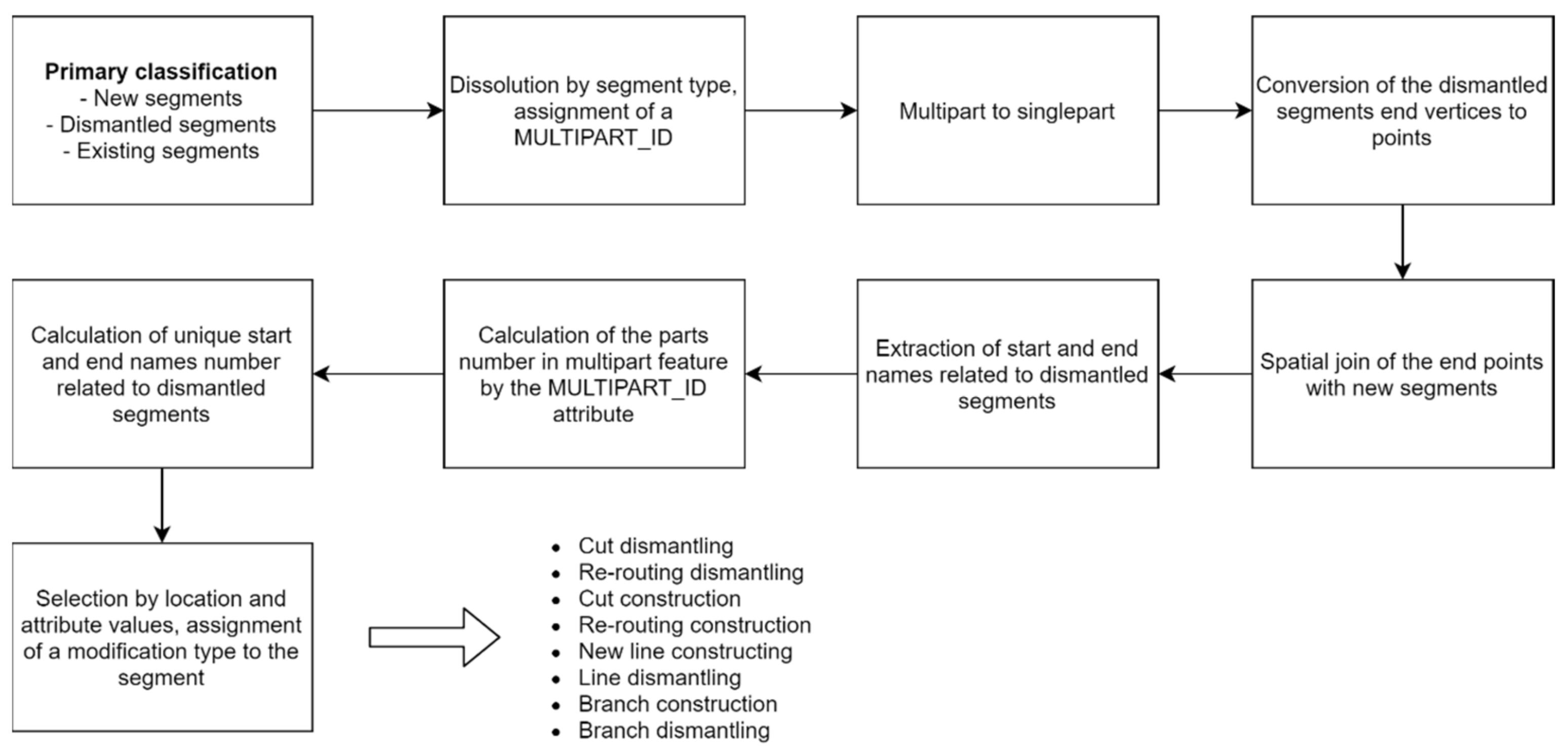
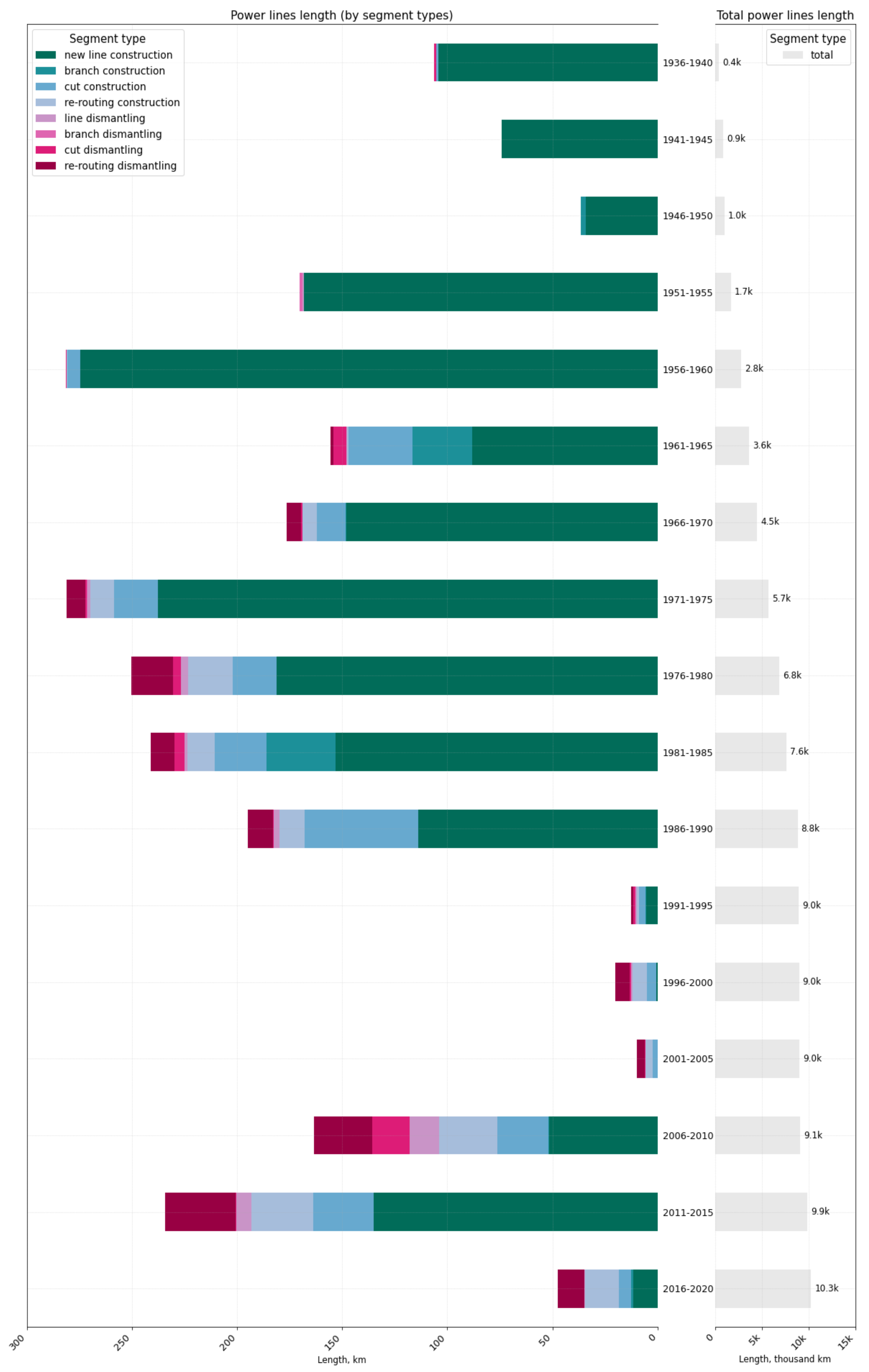
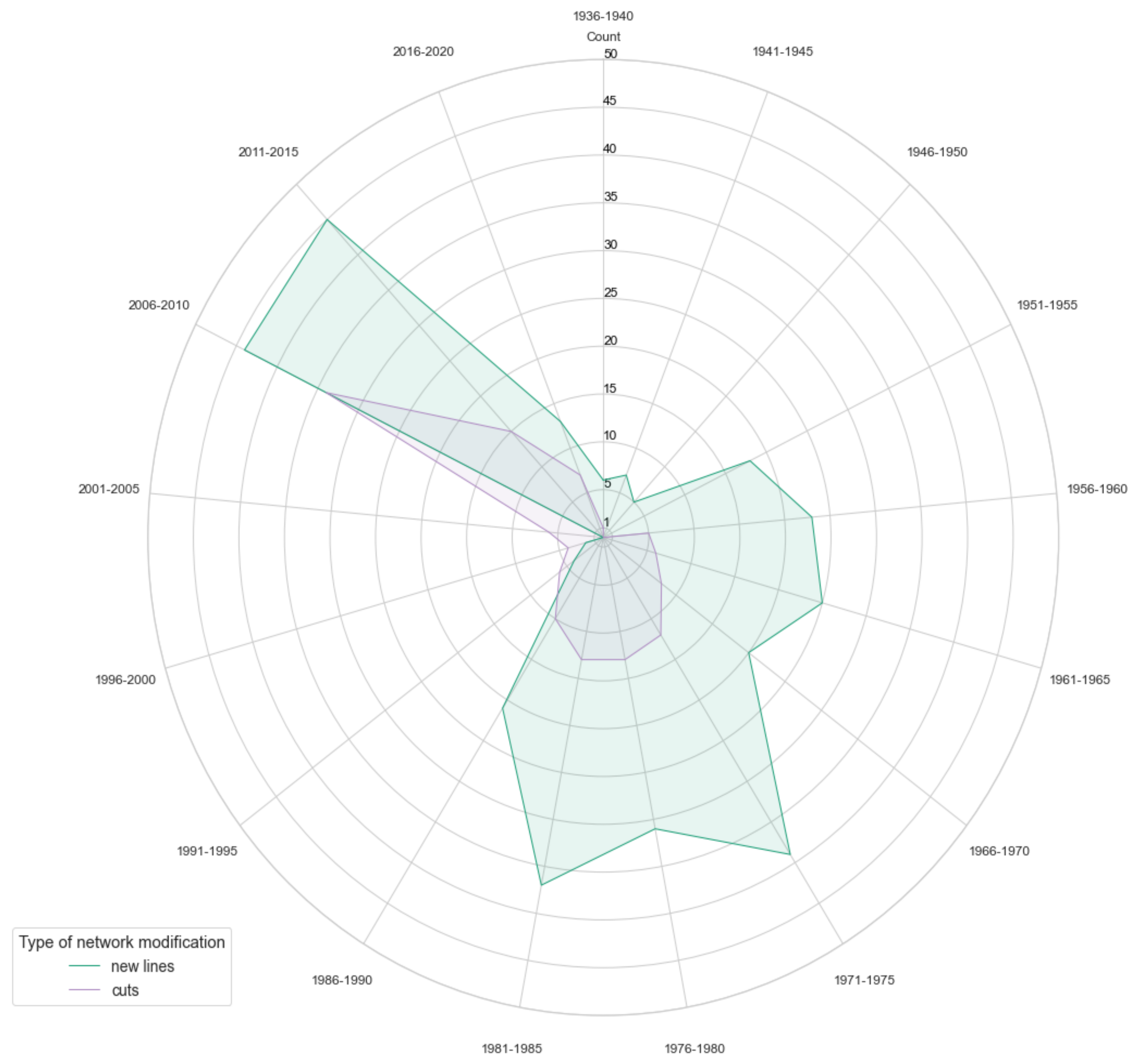
| Acquisition Date | Entity ID | Scene Block | Projective Mean Error, m | Scan Resolution, m |
|---|---|---|---|---|
| 1966-07-16 | DZB00403000058H015001 | a, b, c | 0.48 | 0.8 |
| 1966-07-16 | DZB00403000058H014002 | e, f | 5.95 | 0.7 |
| 1972-02-06 | D3C1202-200198A007 | a, b, c | 5.72 | 1.1 |
| 1972-02-28 | D3C1202-400423F011 | d, e, f | 2.24 | 0.8 |
| 1973-09-01 | D3C1206-300465F005 | c, d, e, f | 2.85 | 1.9 |
| 1973-09-01 | D3C1206-300465A007 | f, g | 8.96 | 1.6 |
| 1976-07-11 | D3C1212-100019F010 | c | 6.86 | 1.4 |
| 1976-09-02 | D3C1212-200485A021 | b, c, d, e | 3.5 | 1.4 |
| 1976-09-02 | D3C1212-200485A023 | d, e | 8.96 | 1.6 |
| 1977-07-22 | D3C1213-100136F007 | b, c | 2.3 | 0.9 |
| # | Column Name | Description |
|---|---|---|
| 1 | GID | geometric reference identifier (foreign key) |
| 2 | Year_start | year of construction |
| 3 | Year_end | year of dismantling (where applicable) |
| 4 | geom | line geometry of the power line segment |
| 5 | fid | unique identifier of the instance |
| 6 | Type | type of segment (overhead or underground cable) |
| 7 | Voltage | voltage carried by the lines |
| 8 | Name | name of the instance |
| 9 | Circuit | number of circuit (where applicable) |
| 10 | isBranch | presence of a branch (where applicable) |
| 11 | Branch_points | list of endpoints linked with the branches (where applicable) |
| 12 | Capacity | capacity of instance (where known) |
| 13 | Name_en | name in English |
| 14 | Start_point | start endpoint reference identifier (foreign key) |
| 15 | End_point | end endpoint reference identifier (foreign key) |
| 19 | Year_start_name | start year of instance |
| 20 | Year_end_name | end year of instance |
| 21 | Doubt_years | reference identifier of doubts in correct year value |
| 22 | Doubt_geometry | reference identifier of doubts in correct geometry |
| # | Column Name | Description |
|---|---|---|
| 1 | GID | geometric reference (foreign key) |
| 2 | Year_start | year of construction |
| 3 | Year_end | year of dismantling (where applicable) |
| 4 | geom | geometry of the endpoint |
| 5 | fid | unique identifier of the endpoint |
| 6 | Name | name of the endpoint |
| 7 | Number | operation number (where applicable) |
| 8 | Name_en | name in English |
| 9 | Alternative name | alternative name (where applicable) |
| 10 | Class | power station, substation or other |
| 11 | Voltage | highest voltage |
Publisher’s Note: MDPI stays neutral with regard to jurisdictional claims in published maps and institutional affiliations. |
© 2021 by the authors. Licensee MDPI, Basel, Switzerland. This article is an open access article distributed under the terms and conditions of the Creative Commons Attribution (CC BY) license (https://creativecommons.org/licenses/by/4.0/).
Share and Cite
Karpachevskiy, A.; Titov, G.; Filippova, O. Development of A Spatiotemporal Database for Evolution Analysis of the Moscow Backbone Power Grid. Data 2021, 6, 127. https://doi.org/10.3390/data6120127
Karpachevskiy A, Titov G, Filippova O. Development of A Spatiotemporal Database for Evolution Analysis of the Moscow Backbone Power Grid. Data. 2021; 6(12):127. https://doi.org/10.3390/data6120127
Chicago/Turabian StyleKarpachevskiy, Andrey, German Titov, and Oksana Filippova. 2021. "Development of A Spatiotemporal Database for Evolution Analysis of the Moscow Backbone Power Grid" Data 6, no. 12: 127. https://doi.org/10.3390/data6120127
APA StyleKarpachevskiy, A., Titov, G., & Filippova, O. (2021). Development of A Spatiotemporal Database for Evolution Analysis of the Moscow Backbone Power Grid. Data, 6(12), 127. https://doi.org/10.3390/data6120127






